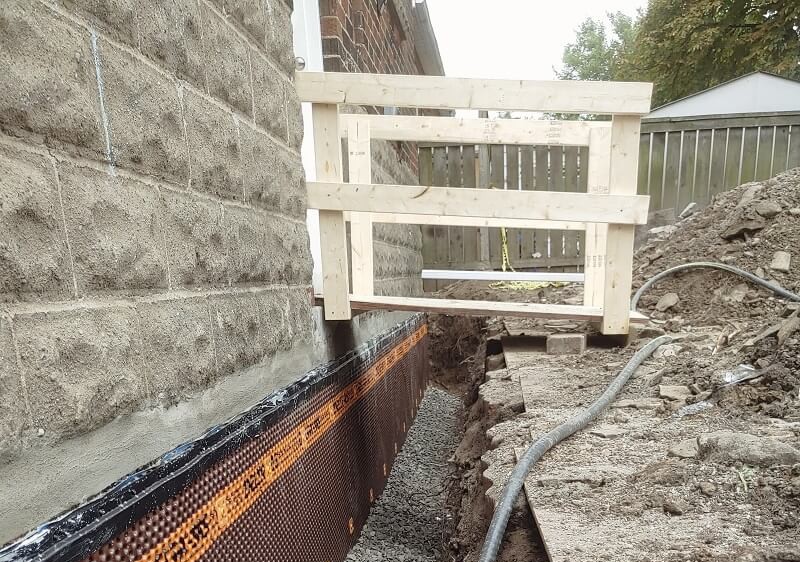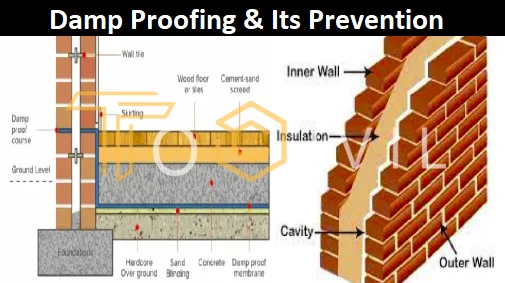What separates rising vs. penetrating damp explained by a damp specialist newcastle
What separates rising vs. penetrating damp explained by a damp specialist newcastle
Blog Article
Understanding the Value of Damp Proofing in Preventing Structural Damage
Damp proofing offers as an important protection against dampness infiltration in structures. This safety action can prevent substantial structural damages, yet many building owners stay not aware of its relevance. Recognizing the indications of wetness and comprehending the various remedies available can be imperative. Disregarding damp proofing can lead to severe repercussions. What are the details risks and remedies that homeowner should take into consideration?
What Perspires Proofing and Just How Does It Function?
Wet proofing offers as an important barrier against dampness intrusion in structures. mould removal newcastle. This procedure involves using details materials and techniques to stop water from penetrating walls, floors, and other structural components. Typically, moist proofing can be accomplished via the installment of wet proof membrane layers, finishes, or using specialized sealants.These techniques function by producing a safety layer that prevents moisture motion, ensuring that the interior atmosphere remains dry and healthy. Damp proofing is particularly important in areas susceptible to high humidity or groundwater, as it assists preserve the honesty of the framework over time.Moreover, efficient moist proofing adds to power effectiveness by avoiding warm loss connected with moist settings. By dealing with prospective moisture concerns before they escalate, damp proofing acts as an aggressive procedure in protecting buildings from the detrimental results of water damages, inevitably prolonging their life-span and preserving their worth
Usual Indications of Moisture in a Building
Moisture problems within a building can show up through numerous noticeable indicators that suggest the presence of wetness. One prominent indication is the look of water spots on ceilings or walls, which often indicates dampness infiltration. In addition, peeling or bubbling paint can recommend that excess humidity is entraped below the surface, bring about wear and tear. One more typical sign is the existence of mold and mildew and mildew, which grow in damp problems and can frequently be recognized by their mildewy smell. An increase in moisture levels can cause condensation on home windows and other surface areas, highlighting dampness troubles. Uneven or distorted flooring may signal underlying moisture that jeopardizes structural honesty. Recognizing these indications early can aid alleviate potential damage and keep a safe living atmosphere. Normal inspections and punctual activity are necessary in addressing dampness issues prior to they intensify.
The Dangers of Ignoring Damp Proofing
Neglecting moist proofing can cause considerable threats to a building's structural integrity, as wetness accumulation may compromise structures and walls. Additionally, prolonged dampness creates a setting for mold growth, positioning serious health hazards to occupants. Attending to these threats is important for guaranteeing both safety and durability of the building.
Architectural Honesty Dangers
When homeowners overlook the significance of efficient damp proofing, they reveal their residential properties to considerable structural honesty risks. Prolonged wetness infiltration can cause the advancement of mold, which weakens fundamental components and can jeopardize overall stability. Furthermore, excess wetness can wear down concrete and brickwork, resulting in cracks and structural failings. Wood elements are specifically vulnerable; they can rot and lose load-bearing capacity, positioning significant risks to the building's framework. In addition, untreated damp conditions may bring in parasites, such as termites, which better exacerbate structural deterioration. Inevitably, ignoring wet proofing steps can result in pricey repairs and possible safety risks, underscoring the crucial role of proactive moist management in protecting the honesty of residential buildings.
Carcinogen Problems
Just how can an apparently small oversight bring about significant health risks? Neglecting wet proofing can create a setting conducive to mold and mildew growth, which presents substantial health and wellness dangers. Mold and mildew spores can set off allergies, respiratory issues, and various other health issues, specifically in prone populations such as youngsters, the senior, and individuals with pre-existing problems. Additionally, consistent moisture can attract parasites like rats and insects, which bring diseases that further compromise wellness. The visibility of dampness additionally adds to a decline in indoor air quality, worsening asthma and other breathing conditions. The failure to resolve damp concerns not only endangers structural stability but likewise jeopardizes the well-being of occupants, highlighting the critical requirement for reliable damp proofing procedures.
Various Kinds Of Damp Proofing Solutions
Although various elements can add to damp issues in buildings, choosing the proper moist proofing solution is important for protecting architectural honesty. A number of alternatives are readily available, each customized to particular conditions.One common remedy is a damp-proof membrane (DPM), normally constructed from polyethylene or bitumen, which is installed in wall surfaces and floors to prevent wetness access. An additional choice is damp-proof courses (DPC), which are layers of water resistant product placed within wall surfaces to obstruct climbing damp.Chemical damp proofing involves infusing waterproofing chemicals right into wall surfaces to produce a barrier against dampness. Furthermore, exterior treatments such as tanking, which involves using a water resistant layer to the beyond foundations, can be effective in avoiding water penetration.Each option has its benefits and is picked based on the structure's certain concerns, ecological conditions, and long-term upkeep factors to consider, guaranteeing suitable protection versus damp-related damages.

The Expense of Damp Damage vs. Avoidance
Comprehending the economic ramifications of damp damage compared to prevention highlights the relevance of proactive procedures. The expenses connected with damp damage can be substantial, consisting of repair services to structural components, mold removal, and possible health-related costs. Homeowners might face substantial monetary pressure if extensive damages takes place, causing raised insurance costs and lost residential property value.In contrast, buying wet proofing options is usually much more economical. First expenses for avoidance approaches, such as improving or setting up damp-proof membranes drainage systems, are often outweighed by the long-lasting cost savings from preventing costly fixings. Furthermore, protecting against moist concerns can enhance a building's general worth and allure, making it a wise investment. When assessing the expense of damp damage versus prevention, it comes to be clear that taking proactive steps can protect economic interests and preserve the honesty of the building gradually.
Picking the Right Damp Proofing Method for Your Building
Which wet proofing method is most suitable for a certain property often depends upon numerous factors, including the building's age, existing wetness concerns, and neighborhood ecological problems. For older frameworks, standard approaches such as bitumen membrane layers or cementitious layers may be a lot more reliable, as they can give a robust obstacle against increasing wet. On the other hand, more recent buildings might gain from modern-day remedies like infused damp-proof training courses, which are much less invasive and can be tailored to specific wetness challenges.Additionally, residential properties in locations with high water tables or heavy rainfall might require even more advanced methods, such as cavity wall surface drain systems or outside waterproofing. House owners need to also consider the certain materials utilized in their structure's construction, as some methods may not work. Ultimately, a thorough assessment by a specialist can guide building owners in picking one of the most effective damp proofing method tailored to their one-of-a-kind circumstances.
Preserving Your Damp Proofing System Gradually
Normal upkeep of a moist proofing system is vital for ensuring its lasting performance and securing a building from moisture-related damage. Residential property proprietors should conduct routine inspections to identify any indicators of wear or concession in the wet proofing layer. This consists of monitoring for fractures, peeling off paint, or mold development, which might indicate dampness intrusion.Additionally, it is suggested to clean rain gutters and downspouts on a regular basis to stop water accumulation around the structure. If deterioration is observed.Engaging professional services for routine evaluations can better boost the sturdiness of the system, reapplying sealers or membranes may be required. These professionals can offer understandings into possible susceptabilities and suggest prompt repairs.
Often Asked Inquiries
How Much Time Does Damp Proofing Treatment Last Prior To Requiring Fixings?
The longevity of wet proofing therapy normally ranges from 10 to thirty years, relying on factors such as the method used, environmental conditions, and upkeep practices. Normal examinations can help identify when fixings might be necessary.
Is Do It Yourself Damp Proofing Effective Compared to Expert Providers?
The performance of DIY damp proofing varies considerably. damp removal newcastle. While some people might achieve satisfying results, expert services normally guarantee complete solutions, leveraging expertise and quality products to avoid future issues more accurately than the majority of do it yourself attempts
Can Damp Proofing Improve Indoor Air Top Quality?
The question of whether moist proofing can improve indoor air quality emerges regularly. Efficient damp proofing decreases wetness levels, thereby reducing mold growth and allergens, ultimately adding to a much healthier interior setting for owners.
Exist Certain Rules for Damp Proofing in Various Areas?
Rules for moist proofing differ by region, usually influenced by local building regulations and environmental conditions. Conformity assurances reliable dampness control, advertising and protecting frameworks safety, which highlights the requirement for adherence click here to these particular regulations.

What Are the Long-Term Benefits of Appropriate Damp Proofing?
The long-term advantages of proper moist proofing consist of improved structural stability, lowered upkeep prices, enhanced indoor air high quality, and boosted residential property worth. These advantages add to a healthier living environment and extended life expectancy of buildings. Generally, damp proofing can be attained via the installment of moist evidence membrane layers, layers, or the usage of specialized sealants.These approaches work by developing a safety layer that prevents dampness motion, making certain that the indoor atmosphere remains dry and healthy. Wet proofing is specifically essential in locations susceptible to high moisture or groundwater, as it helps keep the honesty of the structure over time.Moreover, efficient damp proofing adds to energy performance by preventing warmth loss linked with moist atmospheres. Ignoring damp proofing can lead to substantial threats to a building's structural stability, as wetness accumulation may compromise wall surfaces and structures (damp specialist newcastle). Different aspects can contribute to damp concerns in structures, selecting the suitable damp proofing solution is essential for protecting structural honesty. Which damp proofing technique is most ideal for a specific building frequently depends on different aspects, consisting of the building's age, existing dampness problems, and neighborhood environmental conditions
Report this page